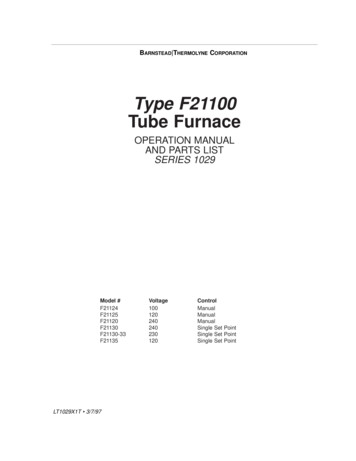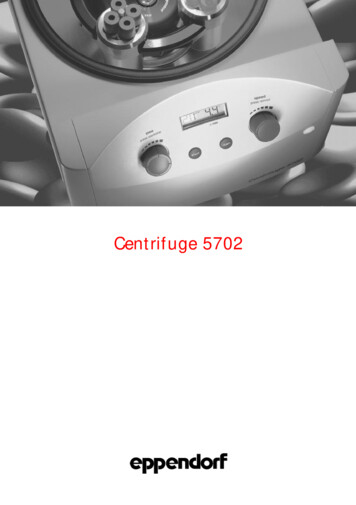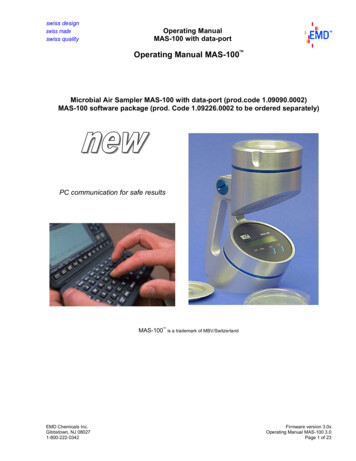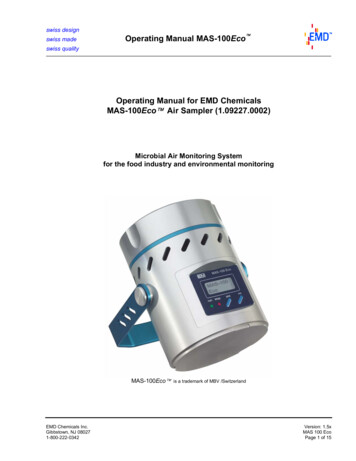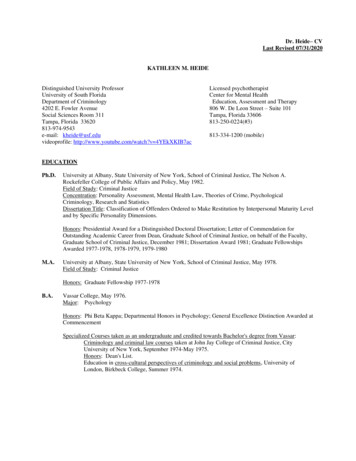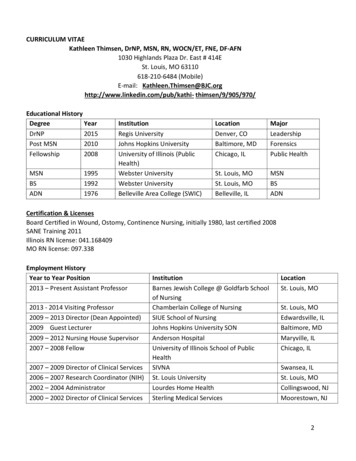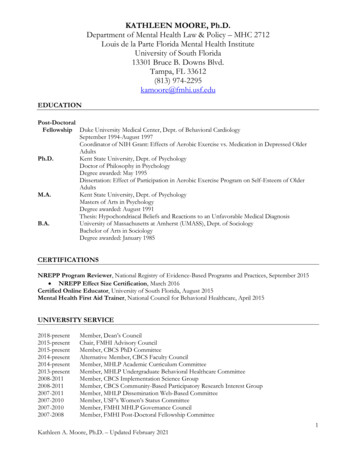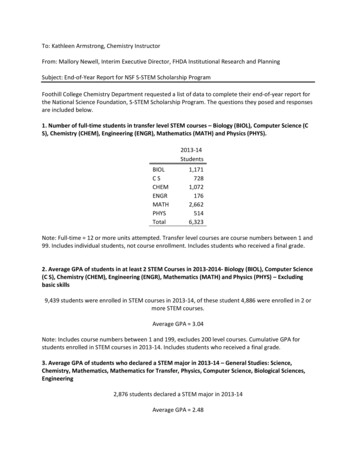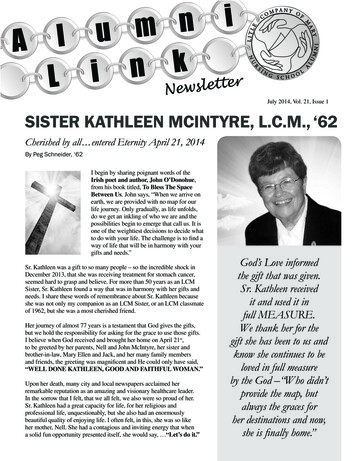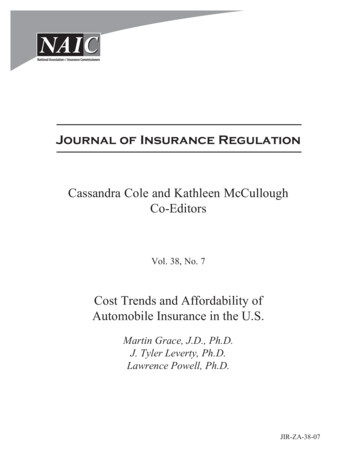
Transcription
Journal of Insurance RegulationCassandra Cole and Kathleen McCulloughCo-EditorsVol. 38, No. 7Cost Trends and Affordability ofAutomobile Insurance in the U.S.Martin Grace, J.D., Ph.D.J. Tyler Leverty, Ph.D.Lawrence Powell, Ph.D.JIR-ZA-38-07
TThe NAIC is the authorittative sourcee for insurance industry iinformation. Our expert solutions suupporttthe efforts off regulators, insurers andd researchers by provididing detailed and compreehensive inssuranceinnformation. The NAIC offersoa wide range of puublications inn the followinng categories: AAccounting & ReportingInformation abbout statutoryy accounting principlespaand the proceedures necesssary for filing financialaannual statemments and connducting risk-bbasedccapital calculaations.Special StuudiesStudies, repports, handboooks and reguulatoryresearch coonducted by NNAIC members on a variettyof insurancee related topics.CConsumer InnformationImportant ansswers to commmon questions aboutaauto, home, healthhand life insurance — as well asbbuyer’s guidess on annuitiess, long-term carecinnsurance andd Medicare suupplement plaans.Statistical Reportsnd in-demandd insurance inndustry-wideValuable anstatistical daata for variouus lines of bussiness,including auuto, home, heealth and life iinsurance.FFinancial ReggulationUUseful handboooks, compliaance guides anda reportsoon financial annalysis, comppany licensingg, stateaaudit requiremments and recceiverships.Supplemenntary ProducctsGuidance mmanuals, handdbooks, surveeys andresearch onn a wide varieety of issues.LLegalCComprehensivve collection of NAIC model laws,rregulations annd guidelines;; state laws on insurancetoopics; and othher regulatoryy guidance onn antifraudaand consumer privacy.Capital Maarkets & Investment Analysisortfolio valuess andInformation regarding poproceduress for complying with NAIC rreportingnts.requiremenMMarket RegulationRRegulatory annd industry guuidance on maarketrrelated issuess, including anntifraud, produuct fi lingrrequirements, producer liceensing and marketmaanalysis.White PapeersRelevant sttudies, guidannce and NAICC policypositions onn a variety of insurance toppics.NNAIC ActivitiesNNAIC member directories, in-depth repoorting ofsstate regulatory activities anda official hisstoricalrrecords of NAAIC national meetingsmand otheraactivities.For moree informatioon about NAAICpublicatiions, visit us at:http://wwww.naic.org///prod servhome.htm 2019 National Association of Inssurance Commmissioners. All rrights reservedd.Printed in the UnitedUStates oof AmericaNNo part of this book may be reproduced, stoored in a retrievval system, or ttransmitted in aany form or by any means, electronic orncluding photoccopying, recordding, or any stoorage or retrievval system, withhout written permission from tthe NAIC.mechanical, inNNAIC Executivee Office4444 North Capitol Street, NWSSuite 700WWashington, DCC 200012202.471.3990NAICNCentral OfficeO11001Walnut SttreetSuiteS1500KansasKCity, MO 64106816.842.36008NNAIC Capital MMarkets& Investment AAnalysis OfficeOOne New York Plaza, Suite 42210NNew York, NY 100042212.398.9000
Companion ProductsThe following companion products provide additional information on the same or similar subject matter. Manycustomers who purchase the Journal of Insurance Regulation also purchase one or more of the followingproducts:Federalism and Insurance RegulationThis publication presents a factual historical account of the development of theframework for insurance regulation in the United States. It does so in part byusing illustrative early statutes, presenting them chronologically, and in part byusing cases that illustrate the interpretation of the crucial later statutes.Copyright 1995.Regulation and the Casualty ActuaryThis anthology reprints 20 important papers from past issues of the Journal ofInsurance Regulation that are most relevant for practicing actuaries and stateinsurance regulators. It covers a wide range of issues, such as ratemaking,auto insurance pricing, residual markets, reserving and solvency monitoring.This invaluable reference explains these complex topics in straightforward,non-technical language. Copyright 1996.International orders must be prepaid, including shipping charges. Please contact an NAIC Customer Service Representative, Monday - Friday, 8:30 am - 5 pm CT.
Editorial Staff of theJournal of Insurance RegulationCo-EditorsCassandra Cole and Kathleen McCulloughFlorida State UniversityTallahassee, FLCase Law Review EditorJennifer McAdam, J.D.NAIC Legal Counsel IIEditorial Review BoardCassandra Cole, Florida State University, Tallahassee, FLLee Covington, Insured Retirement Institute, Arlington, VABrenda Cude, University of Georgia, Athens, GARobert Detlefsen, National Association of Mutual Insurance Companies,Indianapolis, INBruce Ferguson, American Council of Life Insurers, Washington, DCStephen Fier, University of Mississippi, University, MSKevin Fitzgerald, Foley & Lardner, Milwaukee, WIRobert Hoyt, University of Georgia, Athens, GAAlessandro Iuppa, Zurich North America, Washington, DCRobert Klein, Georgia State University, Atlanta, GAJ. Tyler Leverty, University of Iowa, Iowa City, IAAndre Liebenberg, University of Mississippi, Oxford, MSDavid Marlett, Appalachian State University, Boone, NCKathleen McCullough, Florida State University, Tallahassee, FLCharles Nyce, Florida State University, Tallahassee, FLMike Pickens, The Goldwater Taplin Group, Little Rock, ARDavid Sommer, St. Mary’s University, San Antonio, TXSharon Tennyson, Cornell University, Ithaca, NYCharles C. Yang, Florida Atlantic University, Boca Raton, FL
PurposeThe Journal of Insurance Regulation is sponsored by the National Associationof Insurance Commissioners. The objectives of the NAIC in sponsoring theJournal of Insurance Regulation are:1.To provide a forum for opinion and discussion on major insuranceregulatory issues;2.To provide wide distribution of rigorous, high-quality researchregarding insurance regulatory issues;3.To make state insurance departments more aware of insuranceregulatory research efforts;4.To increase the rigor, quality and quantity of the research efforts oninsurance regulatory issues; and5.To be an important force for the overall improvement of insuranceregulation.To meet these objectives, the NAIC will provide an open forum for thediscussion of a broad spectrum of ideas. However, the ideas expressed in theJournal are not endorsed by the NAIC, the Journal’s editorial staff, or theJournal’s board.
1Cost Trends andAffordability ofAutomobile Insurance inthe U.S.Martin Grace, J.D., Ph.D.*J. Tyler Leverty, Ph.D.**Lawrence Powell, Ph.D.***AbstractWe consider the affordability of auto insurance in light of recent increases in itscost. We show that increases in the cost of insurance are correlated with increasesin the cost of losses, not with changes in insurer profits. We review the existingliterature on the affordability of auto insurance and describe the inherent difficultiesof evaluating affordability. We also highlight important limitations in theassumptions and methodologies used in past affordability studies. Finally, weconclude that rate regulation is not an appropriate tool for addressing theaffordability of auto insurance.* Fox School of Business, Temple University, Alter Hall 614, 1801 Liacouras Walk, Philadelphia,PA 19122; mgrace@temple.edu.** Wisconsin School of Business, University of Wisconsin-Madison, 5284A Grainger Hall, 975University Ave., Madison, WI 53706; ty.leverty@wisc.edu.*** Culverhouse College of Business, University of Alabama, 1500 Greensboro Ave., Suite 2,Tuscaloosa, AL 35401; lars.powell@ua.edu. 2019 National Association of Insurance Commissioners
2Journal of Insurance RegulationIntroduction1Automobile insurance represents a significant expense for some drivers in theU.S. In 2017, auto insurance premiums represent 12.6% of transportation expensesand just under 1.7% of total annual expenditures for low-income households. Thecost of automobile insurance has increased from 2009 to 2018. Figure 1 shows thatautomobile insurance costs have risen faster than general inflation and medicalinflation from 2009 through 2018. Hartwig et al. (2016) note that it is common forautomobile insurance prices to decrease during a recession and increase quicklyafter. This may be caused by the correlations among driving, income andemployment.Figure 1: Automobile Insurance Inflation: 2009–2018Source: Bureau of Labor StatisticsThe increase in the cost of auto insurance relative to other goods and servicesmotivates our study. We examine the factors driving cost increases and the effectsof cost increases on affordability to determine if a public-policy response isappropriate and, if so, what an optimal response should involve. For example, if therising cost of auto insurance coincides with windfall profits for insurancecompanies, enhanced rate regulation might be effective. If cost increases reflectincreases in dangerous driving behavior or conditions, investments in law1. The authors appreciate financial support from the Insurance Information Institute. 2019 National Association of Insurance Commissioners
Cost Trends and Affordability of Automobile Insurance3enforcement or transportation infrastructure would be more appropriate. If costincreases are caused by increases in underlying components of automobile insurancecosts (e.g., automobile repair, medical care, and legal services), perhaps a practicalsolution would target these factors instead of insurance.We also consider the affordability of auto insurance. We define an affordablegood as one that is not too expensive for people of limited means to purchase. Giventhe importance of personal vehicles for transportation in many areas and the legaland moral imperatives for drivers to carry insurance, many people believeaffordability of auto insurance for all income levels is an appropriate public-policygoal. However, Schmid (2014) notes that “ affordability is not a straightforwardsubject to study, nor does it have a uniform methodological framework.” Thus, wereview existing studies of auto insurance affordability and perform new analyses toinform policymakers on this topic.As a preview of the results, we find that the cost of auto insurance has increasedin recent years. We find that the recent increase in the cost of auto insurance isstrongly correlated with increases in the frequency and severity of auto accidents.The increase in the frequency and severity of auto accidents is likely due to increasesin the miles driven during a period of economic expansion. The evidence also pointsto distracted driving, the increasing cost of collision repair and medical cost inflationas contributing factors.Some of the contributing factors, such as crash repair costs, should partiallyself-correct over time. Once a critical mass of the vehicle fleet has crash-avoidancetechnology, the reduction in loss frequency should offset at least part of the increasein loss severity. Other factors, like the cost of medical care and related noneconomic damages (e.g., pain and suffering) might best be addressed by changes inpersonal injury protection (PIP) laws,2 antifraud efforts,3 transparency in medicalpricing or civil justice reform. Legal and regulatory characteristics also affect thecost of insurance.We find that the affordability of auto insurance is unrelated to the structure ofauto insurance markets. Auto insurance markets are highly competitive, and insurerprofits have not risen with the cost of automobile insurance. Specifically, we findno correlation between the cost of auto insurance and insurer profitability.Regulating rates in a highly competitive industry is not an appropriate tool foraddressing affordability. In fact, there is considerable evidence that aggressive (i.e.,rate suppressing) rate regulation reduces affordability. Weiss et al. (2010) find thatwhen rate regulation suppresses cost for the riskiest insureds, average premiums,losses and injuries increase. Moreover, we note that the concept of affordability isat odds with the stated purpose of rate regulation—that rates should not be too low2. PIP is a modified form of no-fault auto liability coverage. Generous PIP statutes in certainjurisdictions appear to be associated with higher insurance cost. Michigan just altered its generousPIP statute to allow customers to lower their premiums by choosing lower levels of benefits if theydesire.3. Hoyt, et al. (2006) show that several state laws reduce trends in auto insurance fraud. 2019 National Association of Insurance Commissioners
4Journal of Insurance Regulation(inadequate), too high (excessive) or unfairly discriminatory (based on somethingother than expected losses).The remainder of the article proceeds as follows. In the second section, wedescribe factors affecting the cost of auto insurance. In the third section, we discussstrategies for reducing the cost of insurance. In the fourth section, we review anddiscuss the topic of insurance affordability. In the fifth section, we demonstrate theeffects of flawed assumptions and analyses in several existing affordability studies.In the sixth section, we discuss the use of rate regulation to improve affordability.The final section summarizes our conclusions.Factors Affecting the Cost of InsuranceMany factors can affect the cost of automobile insurance. We first examinewhether changes in insurance prices are related to changes in the losses, expensesor profits of insurance companies. We then consider the underlying factorsassociated with changes in each category.Automobile insurance pays for bodily injury and property damage resultingfrom the ownership and operation of automobiles. Payment is governed by policyforms and business practices that are enforced by state law. Thus, it covers legaldefense in the event a driver is sued. In addition to payments made under insurancecontracts, an insurer must cover its expenses, which include underwriting, lossadjustment, sales and marketing, taxes, and general overhead. The cost ofautomobile insurance must naturally reflect the costs of these goods and services.Expenses are offset by investment income earned on funds held as loss reserves andunearned premiums reserves and policyholders’ surplus. Finally, the cost ofinsurance must include a profit margin that represents a return on capitalcommensurate with risk retained by insurers.Figure 2 demonstrates changes over time in the losses, expenses, investmentincome and profits of the auto insurance industry. Each is shown as a percentage ofnet premiums earned. The loss ratio is the ratio of losses and loss expenses—incurred losses, loss adjustment expenses (LAE), and defense and cost containmentexpenses—to net premiums earned. The expense ratio is non-loss expenses—underwriting, general, marketing and tax expenses—to net premiums earned. Theinvestment ratio is the return on investment funds attributable to insurancetransactions to net premiums earned. The operating ratio represents overall insurerperformance. It is calculated as losses plus expenses minus investment returns,divided by net premiums earned. An operating ratio greater than 100% indicates anoperating loss, while a ratio of less than 100% indicates an operating gain.All four ratios appear steady from 2008 to 2013. After 2013, the loss ratioincreases (through 2016), and the expense ratio decreases. The increase in the lossratio outweighs the decrease in the expense ratio, causing overall performance toweaken (i.e., the operating ratio increases above 100%). The last four years of theanalysis (2014–2017) show zero or negative profit.In examining Figures 1 and 2, itis evident that while automobile insurance costs are steadily increasing over the timeperiod examined, the profitability of auto insurers is not. In fact, the profits of auto 2019 National Association of Insurance Commissioners
Cost Trends and Affordability of Automobile Insurance5insurers are decreasing, suggesting that the increasing cost of auto insurance is likelynot due to insurers extracting excess rents from consumers. We also see little changein investment returns.4Figure 2: Operating Performance and Expense Categories Relative toPremiumSource: NAIC data sourced from S&P Market IntelligenceNotes: Operating ratio is losses plus expenses minus investment gains as a percentage of premium.Next, we examine the correlations of the ratios. We find the correlationcoefficient for the loss ratio and the operating ratio is 0.97. In addition, thecorrelation coefficient for the expense ratio and the operating ratio is –0.54 and thecorrelation coefficient for the investment income ratio and the operating ratio is –0.29. The correlations further suggest that losses are likely the root cause of risinginsurance costs.Several underlying factors are correlated with the increasing levels of autoinsurance losses. These factors include: 1) the number of miles driven; 2) medicalcost inflation; 3) the cost of repairing a vehicle; and 4) the prevalence of distracteddriving.5 We address each factor in turn.First, the number of miles driven has grown quickly as the economy expandedfollowing the “Great Recession.” Figure 3 shows the number of vehicle miles driven4. Investment returns for the entire period considered in Figure 2 are at or near historical lows.The low interest rate environment likely increased pressure on insurers to raise auto insuranceprices, but returns did not change.5. There are many other factors—e.g., driving under the influence of alcohol and drugs,speeding, fraud and uninsured motorists—that affect the cost of auto insurance but do not changesubstantially during the study period. 2019 National Association of Insurance Commissioners
6Journal of Insurance Regulationannually from 1985 through June of 2018. The years in which the U.S. economywas in a recession are shaded in grey. The figure shows that vehicle miles traveledincreases steadily from 1985 to 2006 and then drops from 2007 to 2009. Milesdriven remain relatively flat from 2009 to 2013 and increases thereafter. Figure 3also shows inflation—general inflation and auto insurance inflation—over the sametime period. The correlation between auto insurance inflation and the number ofmiles driven is 0.92. It appears that the rate of auto insurance inflation decreaseswhen economic recessions decrease the number of miles driven. During the time ofsharp increase in auto insurance costs between 2011 and 2018, there is also anincrease in miles driven as the U.S. economy rebounded from a recession.Figure 3: Miles Driven and the Cost of Auto InsuranceSources: Bureau of Labor Statistics, National Bureau of Economic Research and U.S. Department ofTransportationSecond, medical costs have grown over time. Figure 4 shows inflation indicesfor auto insurance, hospital services, medical services and auto bodywork from 1985through 2018. The cost of automobile insurance is highly correlated with medicalinflation (ρ 0.986). This correlation is noteworthy because only 32% of lossesinvolve bodily injury.6 Bodily injury losses are not divided proportionally across all6. See Figure 6 below. 2019 National Association of Insurance Commissioners
Cost Trends and Affordability of Automobile Insurance7types of medical care. Therefore, it is possible that the types of medical careprovided to crash victims face a systematically higher inflation rate than medicalcare in general. In fact, a large percentage of auto insurance injury claims involvehospital treatment, which has risen in cost much faster than other medical services.7Villaveces et al. (2013) find that vehicle crashes account for 2,765,900 emergencydepartment visits in 2010. While one crash often sends more than one person to ahospital, the NAIC Auto Insurance Database Report only shows 1,715,569 bodilyinjury claims in 2010.8 Another exacerbating factor is cost shifting, when medicalproviders charge private payers, such as auto in
Lawrence Powell, Ph.D. JIR-ZA-38-07. T t in A I a a c C I a b in F U o a L C r to a M R r r a N N s r a N N 4 S W 2 he NAIC is he efforts of . ty of issues. stment Anal rtfolio values g with NAIC r ce and NAIC insurance top on about NA s at: . automobile insurance costs have risen fas


